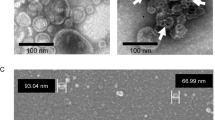Abstract
Type 1 pili are extracellular, supramolecular protein complexes required for the attachment of pathogenic E. coli strains to host cells. Hundreds to thousands of protein subunits are assembled within minutes in vivo and form filaments with unique kinetic stability against dissociation. Here, we review recent work on the structure, assembly mechanism and potential technical applications derived from this exciting biological system.
Similar content being viewed by others
Literatur
Stamm W, Stapleton A (2004) Approach to the Patient with Urinary Tract Infection. In: Gorbach S, Bartlett J, Blacklow N (Hrsg) Infectious diseases. Lippincott Williams & Wilkins, Philadelphia, S 861–872
Thanassi DG, Bliska JB, Christie PJ (2012) Surface organelles assembled by secretion systems of Gram-negative bacteria: diversity in structure and function. FEMS Microbiol Rev 36:1046–1082
Nishiyama M, Vetsch M, Puorger C et al. (2003) Identification and characterization of the chaperone-subunit complex-binding domain from the type 1 pilus assembly platform FimD. J Mol Biol 330:513–525
Vetsch M, Puorger C, Spirig T et al. (2004) Pilus chaperones represent a new type of protein-folding catalyst. Nature 431:329–333
Nishiyama M, Ishikawa T, Rechsteiner H et al. (2008) Reconstitution of pilus assembly reveals a bacterial outer membrane catalyst. Science 320:376–379
Crespo MD, Puorger C, Scharer MA et al. (2012) Quality control of disulfide bond formation in pilus subunits by the chaperone FimC. Nat Chem Biol 8:707–713
Phan G, Remaut H, Wang T et al. (2011) Crystal structure of the FimD usher bound to its cognate FimC-FimH substrate. Nature 474:49–53
Puorger C, Eidam O, Capitani G et al. (2008) Infinite kinetic stability against dissociation of supramolecular protein complexes through donor strand complementation. Structure 16:631–642
Vetsch M, Sebbel P, Glockshuber R (2002) Chaperoneindependent folding of type 1 pilus domains. J Mol Biol 322:827–840
Giese C, Zosel F, Puorger C et al. (2012) The most stable protein-ligand complex: applications for one-step affinity purification and identification of protein assemblies. Angew Chem Int Ed Engl 51:4474–4478
Le Trong I, Aprikian P, Kidd BA et al. (2010) Structural basis for mechanical force regulation of the adhesin FimH via finger trap-like beta sheet twisting. Cell 141:645–655
Choudhury D, Thompson A, Stojanoff V et al. (1999) Xray structure of the FimC-FimH chaperone-adhesin complex from uropathogenic Escherichia coli. Science 285:1061–1066
Author information
Authors and Affiliations
Corresponding author
Additional information
Christoph Giese 2000–2005 Biochemiestudium an der Universität Halle-Wittenberg. 2006–2011 Promotion an der ETH Zürich, Schweiz, dort seit 2011 Postdoktorand.
Rudi Glockshuber 1979–1985 Chemiestudium an der LMU München und am Max-Planck-Institut für Biochemie, Martinsried. 1985–1989 Promotion am Genzentrum der LMU München. 1989–1994 Postdoktorand an der Universität Regensburg. 1994–1997 Tenure-Track-Assistenzprofessor an der ETH Zürich, Schweiz. 1997–2000 Außr — ordentlicher Professor an der ETH Zürich. Seit 2000 Ordentlicher Professor für Molekularbiologie an der ETH Zürich.
Rights and permissions
About this article
Cite this article
Giese, C., Glockshuber, R. Struktur, Assemblierung und Stabilität von Typ-1-Pili. Biospektrum 19, 492–495 (2013). https://doi.org/10.1007/s12268-013-0343-8
Published:
Issue Date:
DOI: https://doi.org/10.1007/s12268-013-0343-8




